Neuronal death in pneumococcal meningitis is triggered by pneumolysin and RrgA interactions with β-actin
- PMID: 33760879
- PMCID: PMC7990213
- DOI: 10.1371/journal.ppat.1009432
Neuronal death in pneumococcal meningitis is triggered by pneumolysin and RrgA interactions with β-actin
Abstract
Neuronal damage is a major consequence of bacterial meningitis, but little is known about mechanisms of bacterial interaction with neurons leading to neuronal cell death. Streptococcus pneumoniae (pneumococcus) is a leading cause of bacterial meningitis and many survivors develop neurological sequelae after the acute infection has resolved, possibly due to neuronal damage. Here, we studied mechanisms for pneumococcal interactions with neurons. Using human primary neurons, pull-down experiments and mass spectrometry, we show that pneumococci interact with the cytoskeleton protein β-actin through the pilus-1 adhesin RrgA and the cytotoxin pneumolysin (Ply), thereby promoting adhesion and invasion of neurons, and neuronal death. Using our bacteremia-derived meningitis mouse model, we observe that RrgA- and Ply-expressing pneumococci co-localize with neuronal β-actin. Using purified proteins, we show that Ply, through its cholesterol-binding domain 4, interacts with the neuronal plasma membrane, thereby increasing the exposure on the outer surface of β-actin filaments, leading to more β-actin binding sites available for RrgA binding, and thus enhanced pneumococcal interactions with neurons. Pneumococcal infection promotes neuronal death possibly due to increased intracellular Ca2+ levels depending on presence of Ply, as well as on actin cytoskeleton disassembly. STED super-resolution microscopy showed disruption of β-actin filaments in neurons infected with pneumococci expressing RrgA and Ply. Finally, neuronal death caused by pneumococcal infection could be inhibited using antibodies against β-actin. The generated data potentially helps explaining mechanisms for why pneumococci frequently cause neurological sequelae.
Conflict of interest statement
The authors have declared that no competing interests exist.
Figures


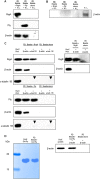
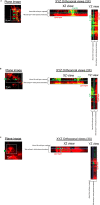
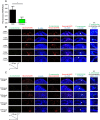
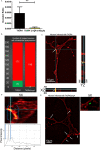
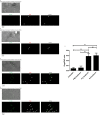
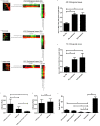
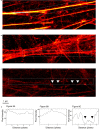
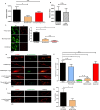
Similar articles
-
Pilus adhesin RrgA interacts with complement receptor 3, thereby affecting macrophage function and systemic pneumococcal disease.mBio. 2012 Dec 26;4(1):e00535-12. doi: 10.1128/mBio.00535-12. mBio. 2012. PMID: 23269830 Free PMC article.
-
Pneumococcal meningitis is promoted by single cocci expressing pilus adhesin RrgA.J Clin Invest. 2016 Aug 1;126(8):2821-6. doi: 10.1172/JCI84705. Epub 2016 Jun 27. J Clin Invest. 2016. PMID: 27348589 Free PMC article.
-
The impact of the ancillary pilus-1 protein RrgA of Streptococcus pneumoniae on colonization and disease.Mol Microbiol. 2020 Mar;113(3):650-658. doi: 10.1111/mmi.14451. Mol Microbiol. 2020. PMID: 32185835 Review.
-
pIgR and PECAM-1 bind to pneumococcal adhesins RrgA and PspC mediating bacterial brain invasion.J Exp Med. 2017 Jun 5;214(6):1619-1630. doi: 10.1084/jem.20161668. Epub 2017 May 17. J Exp Med. 2017. PMID: 28515075 Free PMC article.
-
The Yin and Yang of Pneumolysin During Pneumococcal Infection.Front Immunol. 2022 Apr 22;13:878244. doi: 10.3389/fimmu.2022.878244. eCollection 2022. Front Immunol. 2022. PMID: 35529870 Free PMC article. Review.
Cited by
-
Bacteriophage-derived endolysins restore antibiotic susceptibility in β-lactam- and macrolide-resistant Streptococcus pneumoniae infections.Mol Med. 2025 May 5;31(1):170. doi: 10.1186/s10020-025-01226-1. Mol Med. 2025. PMID: 40325370 Free PMC article.
-
Cholesterol dependent cytolysins and the brain: Revealing a potential therapeutic avenue for bacterial meningitis.AIMS Microbiol. 2023 Aug 21;9(4):647-667. doi: 10.3934/microbiol.2023033. eCollection 2023. AIMS Microbiol. 2023. PMID: 38173970 Free PMC article. Review.
-
Addition of daptomycin for the treatment of pneumococcal meningitis: protocol for the AddaMAP study.BMJ Open. 2023 Jul 25;13(7):e073032. doi: 10.1136/bmjopen-2023-073032. BMJ Open. 2023. PMID: 37491088 Free PMC article.
-
Astrocyte-derived complement C3 facilitated microglial phagocytosis of synapses in Staphylococcus aureus-associated neurocognitive deficits.PLoS Pathog. 2025 Apr 28;21(4):e1013126. doi: 10.1371/journal.ppat.1013126. eCollection 2025 Apr. PLoS Pathog. 2025. PMID: 40294039 Free PMC article.
-
Pore-forming activity of S. pneumoniae pneumolysin disrupts the paracellular localization of the epithelial adherens junction protein E-cadherin.Infect Immun. 2023 Sep 14;91(9):e0021323. doi: 10.1128/iai.00213-23. Epub 2023 Aug 21. Infect Immun. 2023. PMID: 37607057 Free PMC article.
References
-
- van de Beek D, de Gans J, Tunkel AR, Wijdicks EFM. Community-acquired bacterial meningitis in adults. N Eng J Med. 2006. January 5;354(1):44–53 - PubMed
Publication types
MeSH terms
Substances
LinkOut - more resources
Full Text Sources
Other Literature Sources
Miscellaneous

